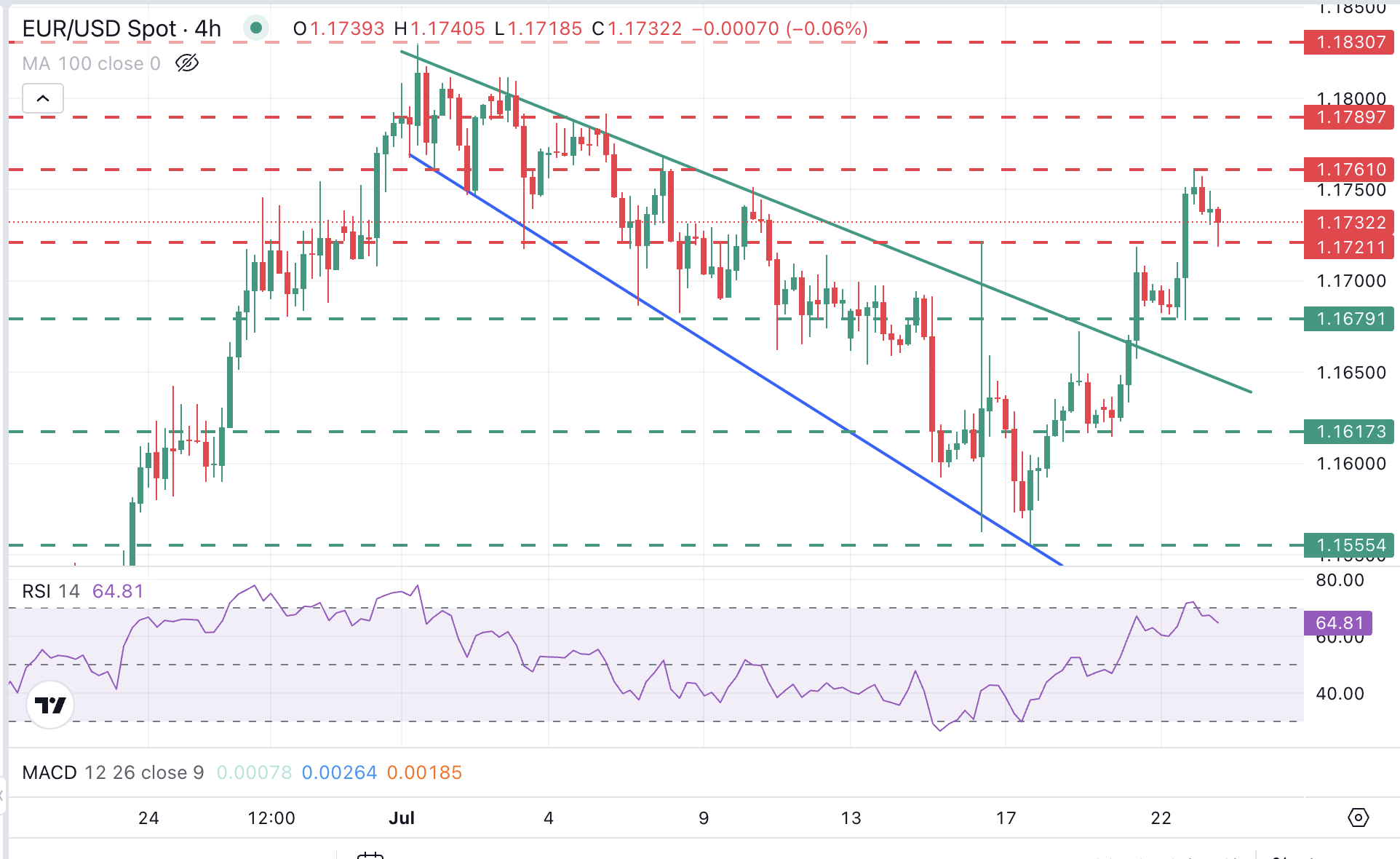EUR/USD retreats from highs amid a stronger US Dollar, tariff deadline fears
- The Euro retreats from over two-week highs against the US Dollar amid growing uncertainty about the EU-US trade deal.
- The US Dollar nudges higher as President Trump announced a "massive deal" with Japan.
- EUR/USD's immediate bias remains positive, with downside attempts limited above previous highs.
The EUR/USD pair is trading lower on Wednesday, giving away some gains following a 1.3% rally over the last three days. Investors' concerns about the lack of progress in trade negotiations between the United States (US) and the European Union (EU), combined with a somewhat stronger US Dollar (USD), are keeping the common currency on the back foot.
The Euro (EUR) retreated from two-week highs of 1.1760 against the US Dollar on Tuesday and is trading around 1.1730 in the early European trading session on Wednesday. The immediate trend, however, remains positive after having bounced from last week's lows at 1.1555, with downside attempts held above a previous resistance at 1.1720.
The pair is correcting lower as the US Dollar picks up from lows following the announcement of a trade deal between the US and Japan. The deal with the European Union, however, remains elusive, and this is keeping investors on edge. EU representatives will be flying to Washington on Wednesday in an attempt to secure a deal, but the bloc is also preparing retaliatory measures in case the negotiations fail.
In the economic calendar, the preliminary European Commission's (EC) Consumer Sentiment Index for July, due at 14:00 GMT, will be the main release on Wednesday. The highlight of the week, however, will be the European Central Bank's (ECB) monetary policy decision on Thursday, which is expected to provide some clues about the bank's near-term policy plans and the Eurozone's economic outlook.
Euro PRICE Today
The table below shows the percentage change of Euro (EUR) against listed major currencies today. Euro was the strongest against the Japanese Yen.
| USD | EUR | GBP | JPY | CAD | AUD | NZD | CHF | |
|---|---|---|---|---|---|---|---|---|
| USD | 0.16% | 0.05% | 0.29% | -0.02% | -0.26% | -0.50% | 0.11% | |
| EUR | -0.16% | -0.11% | 0.12% | -0.18% | -0.44% | -0.65% | -0.05% | |
| GBP | -0.05% | 0.11% | 0.26% | -0.06% | -0.33% | -0.54% | 0.12% | |
| JPY | -0.29% | -0.12% | -0.26% | -0.30% | -0.53% | -0.68% | -0.17% | |
| CAD | 0.02% | 0.18% | 0.06% | 0.30% | -0.22% | -0.27% | 0.16% | |
| AUD | 0.26% | 0.44% | 0.33% | 0.53% | 0.22% | -0.21% | 0.44% | |
| NZD | 0.50% | 0.65% | 0.54% | 0.68% | 0.27% | 0.21% | 0.66% | |
| CHF | -0.11% | 0.05% | -0.12% | 0.17% | -0.16% | -0.44% | -0.66% |
The heat map shows percentage changes of major currencies against each other. The base currency is picked from the left column, while the quote currency is picked from the top row. For example, if you pick the Euro from the left column and move along the horizontal line to the US Dollar, the percentage change displayed in the box will represent EUR (base)/USD (quote).
Daily digest market movers: Euro recovery loses steam on trade uncertainty
- The Euro fails to extend its rally for the fourth consecutive day, as high uncertainty surrounding the trade relationship between the EU and the US and the threat of facing 30% tariffs from August 1 are starting to undermine speculative demand for the common currency.
- Beyond that, traders might be cutting some Euro long positions as markets head into the ECB's monetary policy decision. The bank is widely expected to keep interest rates on hold, as inflation remains steady near the target rate of 2%, but the soft economic momentum of some of the region's major economies and the prospects of a trade war with the US might heighten hopes of further monetary easing in September.
- Later on the day, the preliminary EC's Consumer Sentiment Index is expected to have improved somewhat, to a reading of -15 in July from the -15.3 seen on the previous month. These numbers are well below the long-term average, which reflects a soft economic context. Unless there is a positive surprise, these data are unlikely to provide any significant support to the Euro.
- Earlier on Wednesday, US President Donald Trump announced a "massive trade deal" with Japan. Tariffs on imports from the Asian country have been lowered to 15% from the 25% levy announced a few weeks ago, while, according to Trump, Japan will invest $550 billion in the US. The US Dollar picked up from lows following the news.
EUR/USD maintains its positive bias while above 1.1720

EUR/USD is correcting lower after a significant rally over the last three days, which pushed the 4-hour Relative Strength Index (RSI) to oversold levels. The pair, however, maintains its immediate bullish structure intact, with downside attempts contained above a previous resistance, now turned support, at 1.1720.
Further depreciation below the mentioned 1.1720 (July 16, Monday's highs) would give bears hope for a retest of Tuesday's lows at 1.1680 ahead of a reverse trendline, now at 1.1645. On the upside, Tuesday's high at 1.1760 is capping bulls for now and closing the path towards the July 7 highs at 1.1790 and the long-term highs, at 1.1830, hit on July 1.
Euro FAQs
The Euro is the currency for the 19 European Union countries that belong to the Eurozone. It is the second most heavily traded currency in the world behind the US Dollar. In 2022, it accounted for 31% of all foreign exchange transactions, with an average daily turnover of over $2.2 trillion a day. EUR/USD is the most heavily traded currency pair in the world, accounting for an estimated 30% off all transactions, followed by EUR/JPY (4%), EUR/GBP (3%) and EUR/AUD (2%).
The European Central Bank (ECB) in Frankfurt, Germany, is the reserve bank for the Eurozone. The ECB sets interest rates and manages monetary policy. The ECB’s primary mandate is to maintain price stability, which means either controlling inflation or stimulating growth. Its primary tool is the raising or lowering of interest rates. Relatively high interest rates – or the expectation of higher rates – will usually benefit the Euro and vice versa. The ECB Governing Council makes monetary policy decisions at meetings held eight times a year. Decisions are made by heads of the Eurozone national banks and six permanent members, including the President of the ECB, Christine Lagarde.
Eurozone inflation data, measured by the Harmonized Index of Consumer Prices (HICP), is an important econometric for the Euro. If inflation rises more than expected, especially if above the ECB’s 2% target, it obliges the ECB to raise interest rates to bring it back under control. Relatively high interest rates compared to its counterparts will usually benefit the Euro, as it makes the region more attractive as a place for global investors to park their money.
Data releases gauge the health of the economy and can impact on the Euro. Indicators such as GDP, Manufacturing and Services PMIs, employment, and consumer sentiment surveys can all influence the direction of the single currency. A strong economy is good for the Euro. Not only does it attract more foreign investment but it may encourage the ECB to put up interest rates, which will directly strengthen the Euro. Otherwise, if economic data is weak, the Euro is likely to fall. Economic data for the four largest economies in the euro area (Germany, France, Italy and Spain) are especially significant, as they account for 75% of the Eurozone’s economy.
Another significant data release for the Euro is the Trade Balance. This indicator measures the difference between what a country earns from its exports and what it spends on imports over a given period. If a country produces highly sought after exports then its currency will gain in value purely from the extra demand created from foreign buyers seeking to purchase these goods. Therefore, a positive net Trade Balance strengthens a currency and vice versa for a negative balance.

